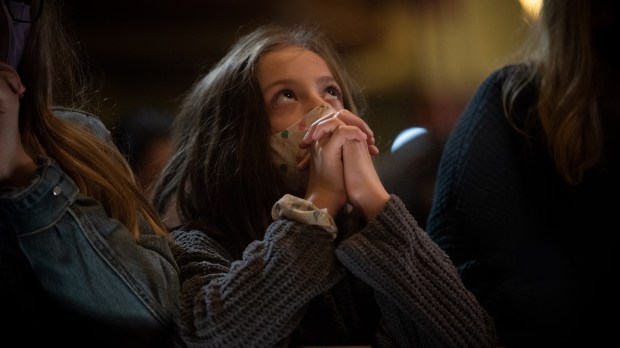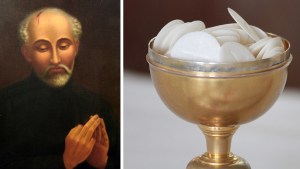If Jesus is truly present in the Blessed Sacrament in the tabernacle of your local parish, then every time you go to Mass, pass the tabernacle, or pass the church, you’re coming close to Jesus Christ himself.
This is great for Catholics, because it builds a loving familiarity with Jesus, but it’s also dangerous for Catholics because we constantly run the risk of taking for granted the presence of Jesus Christ, our Savior.
Here are 10 practices Catholics have adopted to make the most of Jesus’ real presence and avoid the danger.
1: Face the tabernacle when you make the Sign of the Cross.
Making the Sign of the Cross is your declaration that you are living in the Trinitarian life inaugurated on earth by Jesus Christ.
When you make the Sign of the Cross when entering the church or beginning Mass, look at the tabernacle, where Jesus Christ himself is present.
2: Genuflect imagining a king.
The Church expects Catholics to genuflect before the tabernacle because a “genuflection, made by bending the right knee to the ground, signifies adoration, and therefore it is reserved for the Most Blessed Sacrament,” says the General Instruction of the Roman Missal (274).
When this becomes a routine and meaningless gesture to you, try consciously imagining you are genuflecting not before the tabernacle but before the throne of Christ, wearing a crown. This is, in fact, what you are doing.
3: Bow to the altar, the place of his sacrifice.
Another important practice given in the General Instruction of the Roman Missal is to bow to the altar, as the sacred place where the priest will re-present Christ’s sacrifice.
Once Mass begins, the altar and not the tabernacle is the center of attention and we bow to the altar rather than genuflect to the tabernacle.
4: Direct your prayers to the tabernacle.
When you say prayers at Mass, it is good to direct them toward Jesus Christ himself, truly present in the tabernacle.
When you say “Forgive me” during the Penitential Act, “Glory to God in the highest” in the Gloria, or pray the Psalm response, direct them to God by focusing there. After the consecration, direct your prayers to the Lord present on the altar.
5: Offer yourself on the paten
As the Eucharistic liturgy begins, the priest blesses hosts on the paten (the plate), and says “Blessed are you, Lord, God of all creation.” It is an old custom to spiritually put yourself or your intentions on the paten and unite them with his offering.
St. Faustina did this on the day of her religious consecration, praying: “Today I place my heart on the paten where Your Heart has been placed, O Jesus.”
6: Pray “My Lord and My God!” when the host is elevated.
There is a longstanding Catholic custom of recommitting ourselves to the Lord using the words of faith made by “doubting Thomas” when his doubts went away.
7: Pray, “My Jesus, mercy!” when the chalice is elevated.
The same custom repeats “My Jesus, mercy!” to the precious blood, a spontaneous cry of the heart for salvation.
It is best to pray both these exclamations silently. However, I only know them because a man in a downtown parish in San Francisco I attended as a young man whispered them louder than he knew. His heartfelt cry for mercy shaped my understanding of the Lord’s Eucharistic sacrifice.
8: Pray in the Communion line.
As you walk forward to receive Jesus in the Blessed Sacrament, it’s good to pray to prepare yourself and stay recollected. Some popular prayers include:
“O my God, help me to make a good Communion.”
“Mary, my mother, pray to your son for me.”
“My dear angel guardian, lead me to the altar of love.”
9: Make the Sign of the Cross when you drive past a Catholic church.
When you see Jesus Christ present by the side of the road on your errands, it’s appropriate to thank him for being with you and to say a quick prayer to him.
10: Stop and visit if you have time.
If you have the time, don’t just pass and pray; park and walk in. The structure of a quick visit is as easy as your ABC’s:
A is for adoration (say a few words of praise for Our Lord in the tabernacle) .
B is for blessings (thank God for today’s blessings of food, shelter, clothing and goodness, truth and beauty.)
C is for contrition (repent of the times you misused those blessings today)
S is for supplication (say what you want God to supply in your life and others.)



